Table of Contents
Spiritual Illumination, A Myth?
Well, if you are reading this article, it means you are interested or at least curious in this line. However, illumination is not a shelf-product for consumption.
Spiritual illumination has been the most intriguing of all discussions. With the word enlightenment or illumination come many expectations. Hence, it becomes essential to filter out preconceived notions and understand the actual implication of the term ‘enlightenment’.
Today we shall cover the most common myths that people have concerning illumination, and understand what spiritual illumination truly is.
Myth 1: Spiritual Illumination is a fancy thing
People feel that enlightenment appears as a fancy thing, somewhere far off at the horizon. They spin their own web and trap themselves in another concept though.
Also, they keep hearing “Osho”, “J Krishnamurthy”, “Allan Watts”, “Eckhart Tolle” or read the teachings of master Gurdjieff and a whole lot of people. But what is the purpose of such talks?
Are we getting somewhere or just psyching ourselves with the “feel-good” factor, or Placebo Effect? It simply increases the dopamine levels in the blood giving your system food for fake motivation. Nothing worthwhile follows.
We continue to trick ourselves through internal mind chatter, dialogues and endless conversations with like-minded friends who are also in the same freewheeling loop. It simply moves in circles with no tangible output. We have to realize this.

There is nowhere to go…
Well, let me tell you, there is nowhere to go or nowhere to get to. We can just finish off all that is creating stress within us and try to align our life energies to operate with great zest.
That is all there is to the story.
Myth 2 : Spiritual Illuminations Ends all Problems
I guarantee, If you are pursuing enlightenment with a goal of putting an end to problems, challenges and oppositions, then it would be better to drop the idea of enlightenment. Enlightenment cannot serve as an escape route out of challenges and problems. We are constantly tormented by fears, insecurities, uncertainties, never-ending money problems, medical problems, relationship problems and so on.
So, if you think Enlightenment will put an end to all this, you are mistaken. Problems shall continue to be.

But our perception shall change, that which appeared big shall seem minuscule. Enlightenment broadens your vision.
An ant sees a small sugar granule as a mountain in its bound state while an intoxicated elephant shall not even take notice of it. Similarly, enlightenment makes you see the larger picture of things.
Myth 3: Spiritual Illumination shall dawn someday
After listening to mystics and some assumedly wise men, people set up enlightenment goals, trying to reach the horizon. They feel enlightenment shall dawn some day.
However, it keeps distancing itself as they try to clasp it. People are constantly “trying” to “become” good, moral and a whole lot of things that represent goodness, the genuine and the holy.
All said, people start pushing themselves to the goal of Enlightenment.
But the question is, is there something here and now to consume, rather than wait for it to happen in the far-off future? This is a question that keeps raising its hood time and again and is a great de-motivator to the efforts that people put in.
Pursuance of Enlightenment or Spiritual illumination is a damn good idea. But it will continue to remain an idea.

If you keep waiting for it to happen, it never will. Enlightenment can never be a reality that you have imagined it to be. The present makes the future. Hence, waiting for illumination to dawn someday is a good way of cheating yourself.
Myth 4: Spiritual Illumination is a state of Being
Yes, this statement is true but partially. Enlightenment is definitely every soul’s birth right. Yet, all cannot qualify to attain this state.
Just as every Indian citizen has the right to attempt an IPS examination, yet cannot qualify without passing the preparative papers. Unless you are totally convinced about the futility of material existence, enlightenment shall remain a far fetched dream.

True seeking is born only at the consummation of the highest struggle possible, not the survival struggle, but the one that questions existence itself. Only the sincere souls who have seriously questioned the journey of life can take even one step towards this topic.
Myth 5 : Spiritual Illumination Is About Getting Everything and Feeling Satisfied
The world often believes that spiritual illumination brings endless satisfaction, material abundance, and an effortless life where everything aligns perfectly. This is one of the deepest misconceptions. In truth, illumination does not mean that one “gets” everything; rather, it reveals the futility of wanting everything. It sharpens inner awareness to such an extent that you start recognizing how much of your life is governed by conditioning, desire and societal validation.

Real illumination gives you the eyes to see the fakery of the world, the false motivations behind people’s smiles, the hypocrisy behind so-called virtue, and the insecurity hidden behind material display. Yet, it teaches you to live among all this without cynicism or withdrawal.
To be truly illuminated is not to float above life, but to walk firmly within it, anchored in truth and integrity. You learn to hold your center amid contradictions. You stop seeking satisfaction from the world, and instead cultivate the capacity to witness the world without being owned by it. This inner clarity is far more valuable than any sense of outer accomplishment.
Myth 6 : Spiritual Illumination Means Adjusting to Everything
Many assume that enlightenment is about being infinitely tolerant, adjusting to everyone’s ways, and accepting whatever comes as “God’s will.” While compassion and patience are important, this notion is dangerously skewed. True illumination is not about passive adjustability but active discernment. It calls for a quiet firmness that refuses to compromise on what is eternal and pure, Truth (Satya), Righteousness (Dharma), and Integrity (Nīti).

An illuminated being does not bend to the temporary flow of Prakṛti, which is born, grows, decays, and dies, but aligns with Saṃskṛti, the inner refinement that constantly evolves upward. To live by illumination is to detach from what is inappropriate, no matter how socially acceptable it appears, and to remain rooted in what uplifts consciousness. It is not the art of pleasing everyone; it is the discipline of remaining true to the Self.
Myth 7 : Spiritual Illumination Means Constant Bliss
A common misconception portrays enlightenment as a permanent euphoric state, filled with smiles and serenity. The truth is subtler. Illumination removes ignorance, not humanity. An enlightened being still feels the full spectrum of human emotion, grief, joy, compassion, even righteous anger, but is no longer ruled by them. The inner witness remains awake.
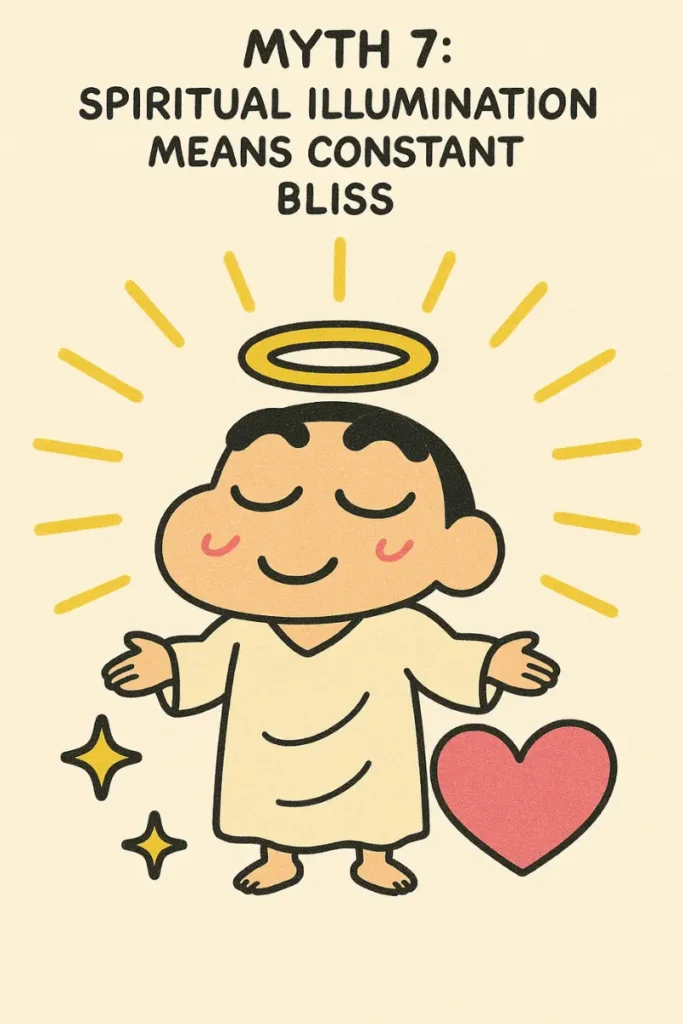
Bliss (Ānanda) is not a mood but a state of alignment. It arises when your thought, word, and deed move in unison with Truth. There may still be tears, but they flow from awareness, not from confusion. Illumination is therefore not an anesthetic to life’s pain; it is the clarity that transforms pain into understanding.
Myth 8 : Spiritual Illumination Can Be Borrowed from Gurus or Books
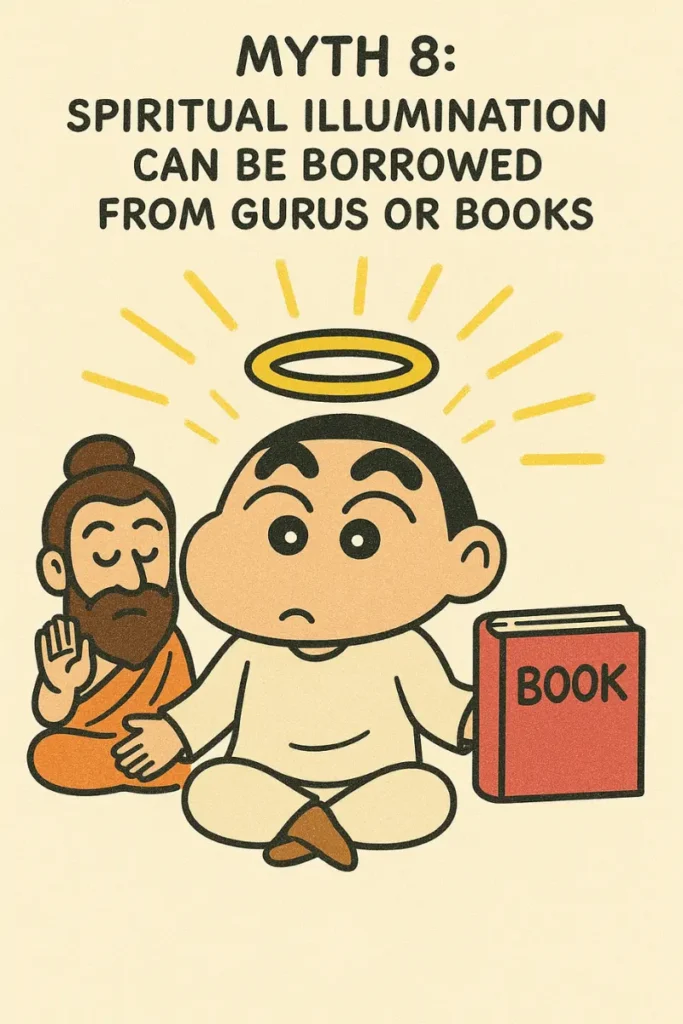
Another myth is that spiritual illumination can be transferred by contact, book knowledge, or attending discourses. These may inspire, but they cannot replace your own inner work. Illumination is experiential, not theoretical. Scriptures, teachers, and practices are like lamps lighting the path, but you still have to walk. The true teacher awakens the fire of inquiry in you; he does not hand over enlightenment as a commodity. It blossoms only when your ego burns in the fire of sincerity and practice.
Myth 9 : Spiritual Illumination Makes You Socially Acceptable
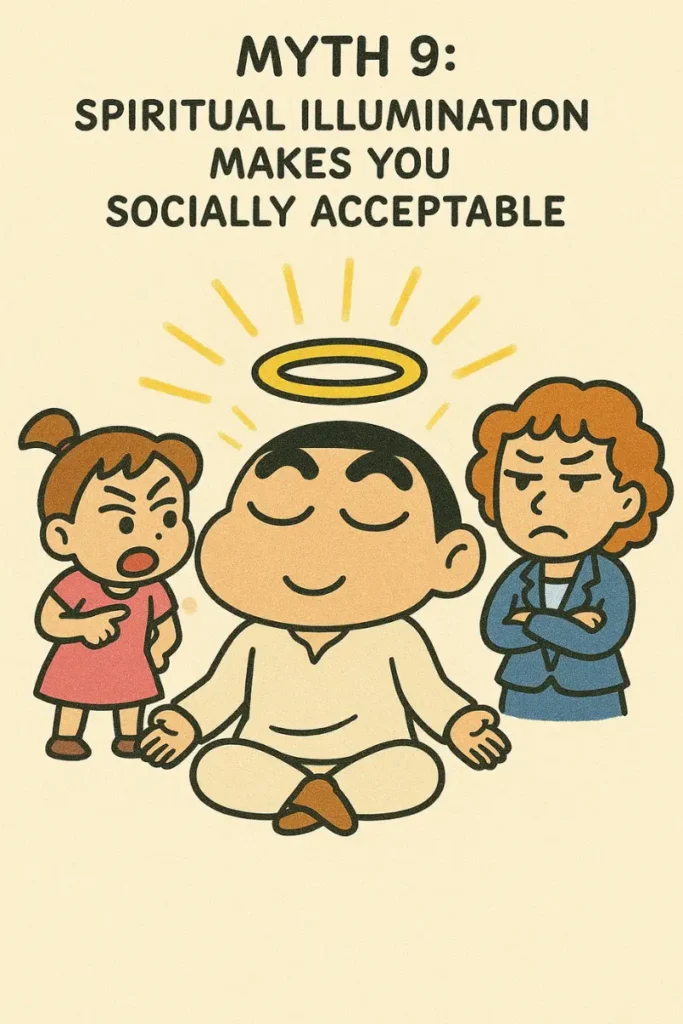
Ironically, genuine illumination often makes one appear non-conforming. Society celebrates comfort and imitation, but illumination strips away pretenses. When you start seeing through illusions, you also stop participating in them, which unsettles others.
Hence, illumination can make you appear detached or even rebellious. But that detachment is not arrogance; it is freedom from falsity. You stop seeking validation because your compass turns inward.
True spirituality may isolate you outwardly, but it connects you inwardly to the vastness of life. Illumination is not about being accepted, it’s about being authentic.
Myth 10 : Spiritual Illumination Is an Escape from Worldly Duties

Some seekers believe enlightenment demands renouncing family, work, and worldly engagement. But detachment does not mean disengagement. An illuminated person fulfills duties with deeper commitment because every action becomes an offering, not an obligation. They may live as householders, artists, teachers, or leaders, but their motivation stems from clarity, not compulsion.
True renunciation is internal: dropping the illusion that anything outside can complete you.
Myth 11 : Spiritual Illumination Happens Only through Suffering

While suffering often awakens introspection, pain alone does not confer wisdom. Countless people suffer yet remain ignorant because they resist learning from it. Illumination begins when suffering is understood, not merely endured. Pain breaks open the ego’s crust, but awareness must flow in to heal it. The illuminated one learns from suffering and transforms it into compassion for others. This alchemy, not the pain itself, leads to awakening.
Myth 12: Spiritual Illumination is for Sadhus
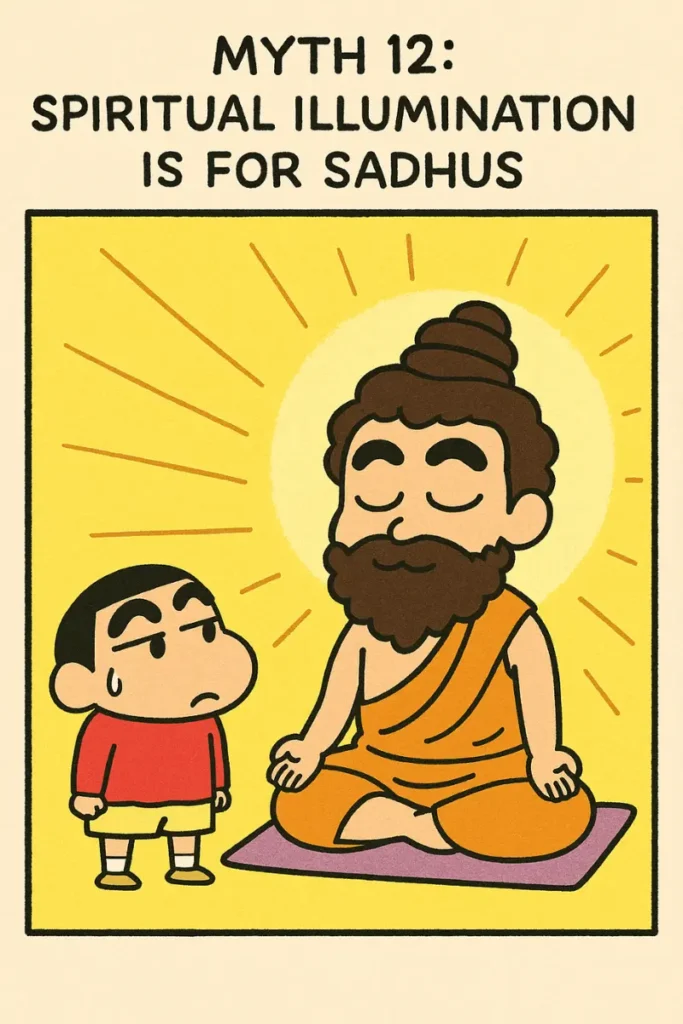
This is the most stereotype of all thought-processes. In fact, people imbibe this mentality from peers and society. Well, enlightenment has nothing to do with social status. A normal householder can be enlightened as well.
Myth 13 : Spiritual Illumination Means Leaving Desires Behind Completely

Many confuse illumination with the total annihilation of desire. In reality, illumination refines desire; it does not amputate it. A spiritually awakened being still desires, but what he desires changes. The longing moves from possession to participation, from taking to giving, from wanting to being. Desire, when purified by awareness, becomes icchā śakti, the divine will that moves creation.
Thus, the goal is not suppression but transformation. When craving ceases to control you, desire becomes prayer.
Myth 14 : Spiritual Illumination Is the Same as Intellectual Understanding
Philosophical knowledge is not illumination. One can quote scriptures flawlessly and yet remain bound by ego. Intellect may understand truth, but only consciousness can realize it. Illumination begins when knowledge ripens into direct insight. It is like the difference between knowing that fire burns and actually touching the flame.
Hence, a truly illuminated being speaks simply, not because he knows less, but because he has dissolved the distance between knowing and being.
Myth 15 : Spiritual Illumination Guarantees Perfection

Illumination does not make you infallible; it makes you responsible. Mistakes may still occur, but awareness quickly corrects them. The difference lies in consciousness. The unenlightened justify their errors; the illuminated learn from them without guilt. They live transparently, free from hypocrisy.
Therefore, illumination is not moral rigidity but moral clarity, the ability to choose the truthful course even when it costs comfort.
Myth 16 : Spiritual Illumination Is a One-Time Event

Many imagine enlightenment as a thunderbolt that ends all seeking. In truth, illumination deepens endlessly. Every realization opens another layer of subtle ignorance to be seen. Awakening may begin in a moment, but abidance in that awareness takes a lifetime of refinement. The light dawns suddenly, but living in that light requires discipline, humility, and continuous remembrance.
Hence, illumination is not a finish line, it is an eternal unfolding.
Myth 17 : Spiritual Illumination Is Detached from Everyday Life
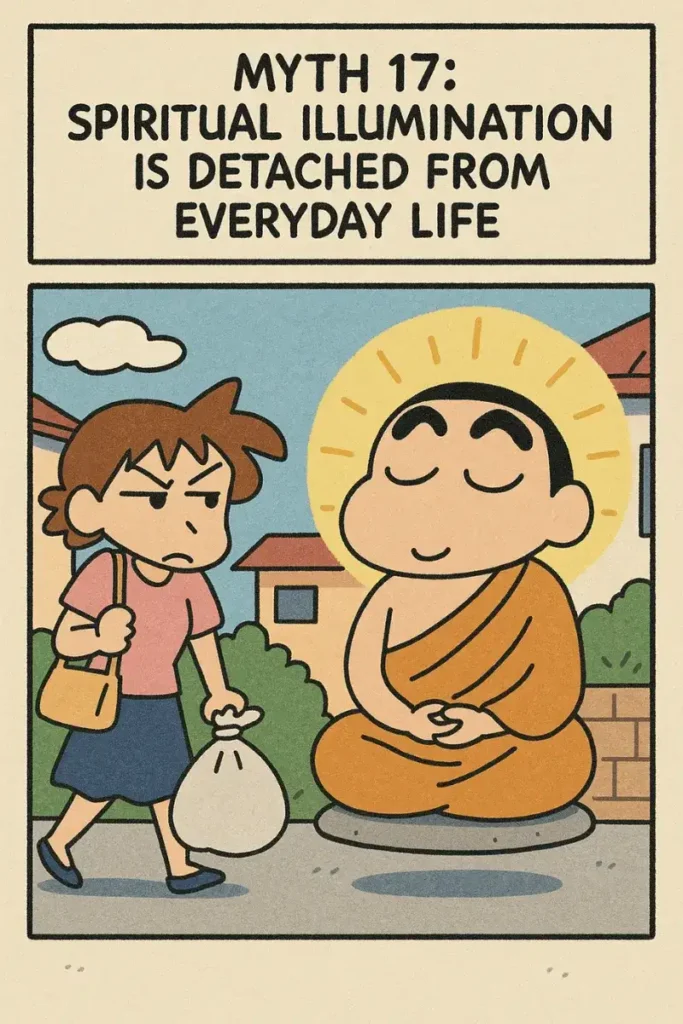
True illumination shines most in ordinary moments, in how one listens, eats, works, forgives, or drives in traffic. Spirituality divorced from life is theory. The test of illumination lies in daily conduct, how we treat the unseen helper, the animal on the street, the colleague who disagrees.
To be illuminated is to live awareness moment by moment, turning routine into ritual and chaos into clarity.
Myth 18 : Spiritual Illumination Equals Material Success

Modern society often confuses spiritual progress with outer prosperity. A calm face, a good following, or a luxurious ashram is mistaken for realization. But illumination is inward wealth, it shines even in poverty. A beggar can be illuminated, while a king can remain bound. Success and failure lose meaning when the inner witness awakens.
Illumination does not make you rich or poor, it makes you content. When one sees through possessions, they serve rather than enslave. That is real mastery.
Myth 19 : Spiritual Illumination Means Emotional Detachment

Detachment is often misread as coldness. In truth, illumination expands sensitivity without sentimentality. The illuminated heart feels more deeply, not less. But it feels without drowning. Compassion replaces attachment. Love becomes giving, not grasping. The illuminated being can weep with others yet remain peaceful within, a rare balance that ordinary emotions cannot sustain.
Myth 20 : Spiritual Illumination Neglects Culture or Dharma

True illumination does not float above culture, it perfects it. Illumination is alignment with Sanātana, the timeless principles that uphold creation. While Prakṛti grows, stabilizes, decays and dies, Saṃskṛti refines, uplifts and preserves. To be illuminated is to protect Saṃskṛti even amidst modernity, to live truth without fanaticism, and compassion without compromise.
An illuminated being is not anti-culture but the very essence of cultured living.
Myth 21 : Spiritual Illumination Removes All Fear of the World

Even the illuminated may feel momentary fear, but they no longer live from fear. Their anchor is within. They have seen that everything outside changes, fortune, reputation, relationships, body. Yet, behind this flux is the unchanging center of consciousness.
Illumination replaces reactive fear with steady courage. The world may shake, but the light within does not. Before we looking more into spiritual illumination further, let us create an environment of peace through the Griha Klesha Nivaran Yantra.
The Powerful Griha Klesh Nivaran Beesa Yantra
Structure of the Griha Klesh Nivaran Beesa Yantra
The Griha Klesh Nivaran Beesa Yantra is a sacred geometrical design crafted to neutralize domestic conflicts and restore peace and harmony within a household. The yantra is drawn within a square boundary symbolizing protection and stability, enclosing a series of intersecting divisions that form nine principal compartments. Each compartment bears a numeric vibration in Devanagari script , १ (1), २ (2), ३ (3), ४ (4), ५ (5), ६ (6), ७ (7), ८ (8), ९ (9) , arranged in a balanced pattern.

Numerologically, this arrangement aligns with the total of 45, which reduces to 9, the number of Mars (Mangal), representing energy, courage, and transformation. This balance of numbers signifies resolution of inner and outer tension, transforming aggression into calm discipline. When kept in the home, it harmonizes planetary influences causing disputes, ensuring peace and positive communication among family members.
Mantras to Activate the Griha Klesh Nivaran Beesa Yantra
Before installation, the yantra must be purified and awakened through mantra recitation. The following mantras invoke peace and harmony, activating the divine energy within the geometric form:
Main Mantra (Beeja-based):
ॐ ह्रीं क्लीं बीसा नमः ॥
Supplementary Mantra for Home Peace:
ॐ शान्तिः शान्तिः शान्तिः ॥
Chant the above mantras 108 times daily while meditating on the central bindu (dot) of the yantra. The vibrations of Hreem and Kleem energize the atmosphere, dissolve negativity, and restore mutual understanding. Ideally, the yantra should be installed on a clean wall in the northeast or east-facing part of the home after sunrise on a Friday or Monday.
How Griha Klesh Nivaran Yantra is Prepared at YantraChants.com
At yantrachants.com, each Griha Klesh Nivaran Yantra is hand-drawn on natural Bhojpatra or high-purity copper plates using traditional red vermillion ink. The geometric precision is ensured through sacred proportioning methods derived from Tantra Shastra.

The yantra undergoes ritual shodhana (purification) with cow’s milk, Ganga water, and sandal paste, followed by prana-pratishtha (energization) performed by Guruji Shri Damodar Das Ji Maharaj. Each yantra is chanted over with specific Beeja Mantras to awaken its subtle frequency of harmony and reconciliation. Unlike commercial prints, the yantras from yantrachants.com carry the Guru’s living transmission , a vibrational blessing that makes the yantra spiritually active the moment it is installed in the devotee’s home.
The Role of a Self-Realized Guru in Yantra Energization
A yantra becomes spiritually alive only when energized by a Self-realized Guru. The Guru bridges the subtle realms of mantra and geometry, infusing the yantra with divine consciousness (Chaitanya). Without this transmission, the yantra remains a mere design. The Guru performs the prāṇa-pratiṣṭhā (infusion of life-force) through focused intent, breath, and sacred mantra vibrations. In the case of the Griha Klesh Nivaran Yantra, the Guru channels the harmonizing power of Shanti Shakti , the force that calms mental turbulence and domestic discord.

Through the Guru’s grace, the yantra becomes a living spiritual circuit that aligns the seeker’s inner vibration with divine peace. Such Guru-energized yantras not only pacify conflicts but also help family members evolve spiritually by cultivating patience, understanding, and compassion , the real antidotes to all forms of Klesh (suffering).
Frequently Asked Questions (FAQs) on Griha Klesh Nivaran Beesa Yantra and Inner Peace
Q1. What is the Griha Klesh Nivaran Beesa Yantra?
A. The Griha Klesh Nivaran Beesa Yantra is a sacred geometrical diagram used to neutralize domestic quarrels, misunderstandings, and negative vibrations within a home. It harmonizes the subtle energy field of the dwelling, promoting mutual understanding and peace among family members.
Q2. What does “Griha Klesh” mean?
A. “Griha” means house and “Klesh” means disturbance, suffering, or conflict. Together, the term refers to household disharmony , the yantra’s purpose is to remove such klesh and restore a sattvic, harmonious environment.
Q3. What is unique about the Beesa form of the Yantra?
A. The Beesa form contains powerful numeric alignments and angular energy grids that channel Mars energy into peaceful action. It balances fiery emotions and converts arguments into constructive understanding.
Q4. Where should I place the Griha Klesh Nivaran Beesa Yantra at home?
A. It should be placed in the northeast direction of the house or living room, at eye level, preferably facing east. Avoid placing it near restrooms or dark corners. Keeping it clean and regularly energized maintains its positive influence.
Q5. How do I meditate on the Griha Klesh Nivaran Beesa Yantra?
A. Sit comfortably before the yantra, light a lamp, and focus your gaze gently on the central symbol “९”. Breathe slowly. Chant softly:
Hreem Kleem Beesa Namah
Let the numbers dissolve into light in your awareness , this connects you to the yantra’s balancing frequency.
Q6. How long should I meditate on it daily?
A. Start with 5 to 10 minutes daily and gradually extend to 15–20 minutes. Consistency is more important than duration. Over time, your mind will become more centered, and household vibrations will begin to harmonize.
Q7. Can this yantra be kept in the office too?
A. Yes. It can be installed in offices, shops, or business spaces where frequent disputes, mistrust, or communication issues occur. It encourages cooperation, fairness, and understanding among colleagues.
Q8. What metal or material is best for the yantra?
A. Traditionally, it is drawn on Bhojpatra using red vermillion ink, or etched on pure copper or brass. These metals hold and transmit subtle energy efficiently when energized by mantra and Guru’s blessings.
Q9. Does the yantra work automatically after installation?
A. No. While it radiates some inherent harmony, true activation happens only through mantra japa and Guru’s prāṇa-pratiṣṭhā. The yantra’s power grows with your faith, purity, and regular sādhanā.
Q10. What mantra should I chant before meditating on it?
A. You can recite:
Hreem Kleem Beesa Namah
This mantra carries the essence of divine reconciliation and balances emotional frequencies. Chant it 108 times daily with calm focus.
Q11. Can one yantra serve the entire family?
A. Yes. A properly energized yantra radiates peace throughout the dwelling, influencing all who reside within its energy field. However, all members should respect and maintain a peaceful attitude near it.
Q12. How does the yantra actually bring harmony?
A. Through sacred geometry and mantra vibrations, the yantra recalibrates the home’s energetic field, reducing aggressive Mars or Rahu influence and invoking Venusian harmony and Jupiterian wisdom.
Q13. What if there is still conflict even after installation?
A. Continue your sādhanā patiently. A yantra is not a quick fix but a spiritual amplifier , it magnifies your effort towards peace. When combined with patience, forgiveness, and prayer, results become tangible.
Q14. How do I cleanse the yantra periodically?
A. On Fridays or full moon days, wipe it gently with rose water or cow’s milk, then dry with a clean cloth. Light incense and chant Om Shantih Shantih Shantih to reactivate its vibrations.
Q15. What happens if the yantra gets damaged?
A. If torn or cracked, wrap it respectfully in a red cloth and immerse it in a flowing river or temple pond. Then, replace it with a freshly consecrated one from a Guru-guided source like yantrachants.com.
Q16. How does inner peace relate to outer peace at home?
A. Outer peace is a reflection of the inner mind. When one cultivates calmness, compassion, and silence within, those vibrations radiate outward, transforming relationships and environments naturally.
Q17. How can I reduce anger and ego in relationships?
A. Chant Om Shantih Shantih Shantih whenever anger arises. Pause, breathe, and remember: “I can choose peace over reaction.” Meditating on the yantra helps anchor this awareness.
Q18. What is the spiritual root of family conflicts?
A. Most conflicts stem from attachment, expectation, and ego , the three forms of klesh described in the Yoga Sutras. Awareness, humility, and devotion to the Divine gradually dissolve these roots.
Q19. How can one begin a spiritual path while living a normal life?
A. Start small , a few minutes of prayer, daily gratitude, mindful speech, and regular meditation. True spirituality begins in the family, through kindness and self-control in daily interactions.
Q20. Why is forgiveness important for peace?
A. Forgiveness is inner liberation. Holding anger binds your energy; releasing it opens your heart. The yantra helps you energetically shift from resentment to acceptance.
Q21. Can chanting alone establish peace without a yantra?
A. Yes, sincere chanting can purify the heart. However, when combined with a yantra, it becomes more focused , like light passing through a lens, amplifying the power of your prayer.
Q22. How do I know if the yantra is working?
A. Signs include reduced tension, calmer communication, more mutual respect, and an inner feeling of warmth or serenity when near the yantra. Over time, the home feels “lighter.”
Q23. What role does gratitude play in maintaining harmony?
A. Gratitude shifts energy instantly. Thanking family members, the Divine, and even challenges cultivates grace. A grateful heart cannot harbor prolonged conflict.
Q24. Can meditation on the yantra open spiritual insight?
A. Yes. As your mind becomes still, the geometric order of the yantra mirrors cosmic intelligence. You begin to intuitively perceive harmony, balance, and divine interconnectedness , the essence of peace.
Q25. What is the highest teaching behind this yantra?
A. That peace begins within. The yantra is not an external charm but a mirror , reminding you that the universe responds to your inner vibration. When you align your thoughts, words, and actions with love and truth, the home transforms into a temple.
What Is True Spiritual Illumination?
Enlightenment for me just means “lighting up the environment.” The path leading to enlightenment has to be a progressively lit path, lit by our eagerness or earnestness. “Life can never be rid of problems.”
So enlightenment is just about living in the now without any qualms or ruffles. Every moment of life should be pleasurable and enjoyed to the brim. One must learn to live in complete cohesion with what is available in and around oneself. Living life without specific opinions, biases, likes or dislikes and simultaneously having a well-balanced approach is all there is to enlightenment.
When one breaks all dogmatism, conceptions, idealism, and opportunism and yet has no problems with them, one shall have well ended one’s enlightenment seeking. This is the highest attainable state.
Conclusion : The Practical Light of Illumination
To be spiritually illuminated is not to abandon the world but to see through it clearly.It is to recognize the transient nature of appearances and yet participate in them with love and balance. Illumination is not about being superhuman; it is about being truly human, anchored in awareness, fearless in truth, and free from inner pretenses.
It integrates the sacred with the secular, turning everyday existence into a field of practice. In relationships, illumination expresses as empathy without attachment. In work, it expresses as excellence without obsession.
Illumination harmonizes Saṃskṛti (inner refinement) with Prakṛti (outer nature). The more one grows within, the more gracefully one acts without. The illuminated being becomes a bridge between heaven and earth, rooted in Sanātana, yet responsive to the times. Ultimately, spiritual illumination is not about escaping the world, but about illuminating it from within. It is not about adjusting to hypocrisy but about standing in Truth even when the world trembles.
When that awareness becomes effortless, when the distinction between meditation and life dissolves, illumination is complete.
Spiritual Illumination and the Intelligence of Grace
Spiritual illumination is ultimately the flowering of divine intelligence within the human frame. It is not merely awareness or peace, it is clarity. This clarity arises only when every inner deficiency is removed through Grace. And Grace never comes accidentally; it descends through the Guru, through obedience, humility, and surrender to a living current of wisdom.
The Guru does not give us new information; he purifies our perception. His instruction, sādhanā, becomes the method by which the mind learns to yield, the ego learns to bow, and the heart learns to receive. When obedience ripens into surrender, what remains is receptivity. Grace begins to work silently, rearranging one’s inner chemistry.
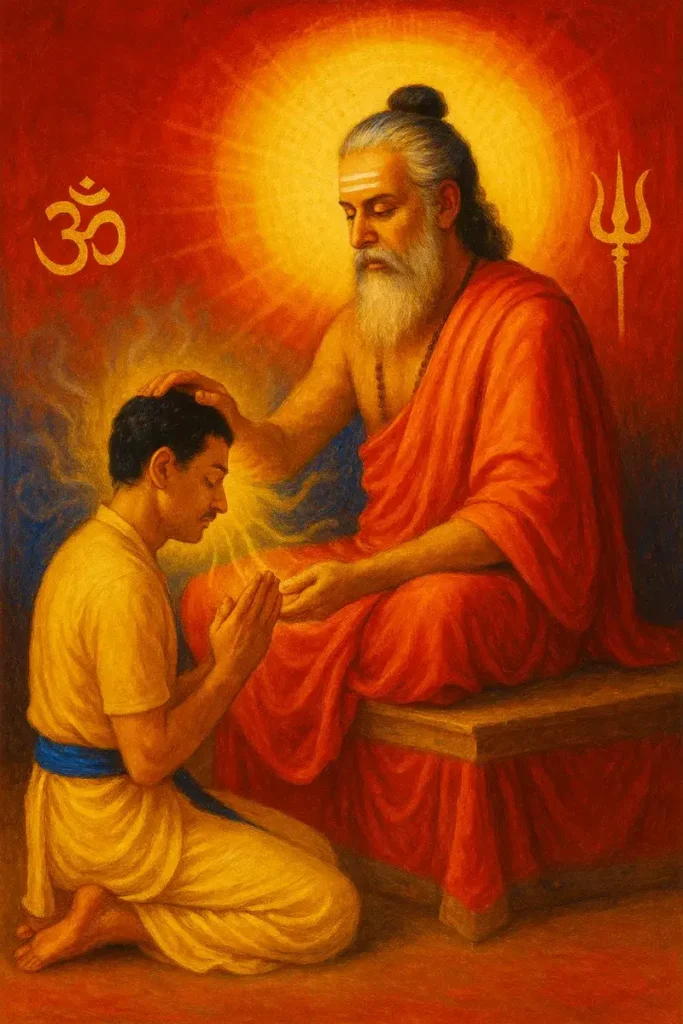
At this stage, Bhagavān becomes central to illumination. Without Bhagavān there can be no Grace, and without Grace there can be no illumination. To understand Bhagavān is to understand the very nature of divine completeness. The Sanskrit word “Bhagavān” itself reveals the secret, it is formed of six noble qualities (bhaga):
Aiśvarya , supreme lordship and sovereignty;
Vīrya , inexhaustible strength and valor;
Yaśas, eternal glory that uplifts others;
Śrī, auspicious prosperity and radiance;
Jñāna, perfect wisdom that knows all things;
Vairāgya (the last one) , renunciation, detachment from all that is perishable.
These six together constitute the living perfection called Bhagavān. Each quality corresponds to an inner transformation within the seeker: the courage to face truth, the clarity to know, the grace to prosper rightly, the humility to serve, the steadiness to persevere, and, above all, the renunciation that brings freedom.
Of all the six, it is Vairāgya, renunciation, that becomes the golden key to Grace. When desires fade, the heart becomes hollow enough for divine light to fill it. The mind by nature only knows how to attach, it clings, collects, and identifies. It does not understand detachment. Therefore the only safe attachment for the mind is Bhagavān Himself, through the channel of the Guru.
When the mind attaches completely to Bhagavān, it begins to detach from everything else without effort. This is not escapism or external renunciation; it is the shift of dependence, from matter to Spirit, from world to Source. To depend on Bhagavān is to depend on that which never fails.
When such dependence becomes natural, Grace opens like dawn, flooding the inner world with unmistakable intelligence. Spiritual illumination then ceases to be a concept, it becomes a living presence, an awareness guided by divine order, a clarity that cannot be shaken by circumstance.
In that state, one no longer “seeks” light, one becomes it.
Living Intelligence , When Grace Becomes Experience
To understand this intelligence is not to grasp it intellectually but to feel life as it is unfolding within and around you. There comes a day when a seeker, despite knowing all the scriptures and having repeated the mantras countless times, suddenly pauses and senses a subtle exhaustion. All that once seemed profound now feels repetitive. Outward effort no longer moves anything inside. This is the threshold where Divine Intelligence begins to whisper.
The Guru’s presence or even a remembered word can turn this weariness into a doorway. The seeker begins to see the very movement of his mind, the endless wanting, comparing, and worrying, as the cause of obscurity. He sits quietly, not to “meditate,” but to truly feel.

He notices how each desire creates a restlessness in the heart, how each memory reshapes perception, and how identity hides behind emotions. That noticing, when done without judgement, becomes the first spark of intelligence.
Slowly, this sensitivity deepens into reverence. Every experience, joy or pain, becomes material for inner education. A disappointment at work shows him the fragility of ambition. An argument at home mirrors his need for control. Even physical tiredness teaches him where he has been resisting flow. Nothing is wasted when seen through the eye of awareness.
This is how life itself begins to teach. The Guru’s instruction is not separate from these moments; it pervades them. The intelligence that flowers here is not analytical, it is existential clarity. One begins to sense when energy is scattered and when it is centered. The choices that once sprang from emotion start emerging from stillness. Speech becomes measured. The eyes grow softer. Judgments dissolve. This is not weakness; it is strength anchored in insight.
At such a stage, prayer changes its texture. It is no longer a list of requests but a silent attunement. One no longer seeks miracles; one seeks alignment. Bhagavān ceases to be a distant deity and becomes the living rhythm behind breath, heartbeat, and thought. To depend on Bhagavān, then, is not blind faith, it is the deepest intelligence possible. For when one depends on the Eternal, one stops depending on the temporary.

In this quiet dependence, surrender matures into freedom.The mind, once restless, becomes transparent like a river after the storm. The same world remains, the same people, the same duties, but everything is seen through the lens of truth rather than expectation. Grace becomes tangible; one begins to recognize its signature in daily events, an unexpected help, a calming insight, a gentle nudge away from danger.
This is how illumination feels when lived. It is not a fireworks of visions or powers; it is the fragrance of equilibrium.One works with more precision, loves with more purity, and walks with more patience. There is no longer any rush to reach somewhere because the light that was being sought has revealed itself as one’s very own awareness.
When such intelligence ripens, life itself becomes scripture. Every action, every meeting, every breath carries instruction from Bhagavān. Nothing is outside His order. To live in that understanding is to live illuminated, not as an idea but as a living force of clarity guided by Grace.
What is True Spiritual Illumination?
Enlightenment for me, just means “Lighting up the Environment”. The path leading to environment has to be a progressively lit path, lit by our eagerness or earnestness. I say this with whatever experienced I have gained in life, and the realizations dawned through spiritual practice and associating with wise men.
“Life can never be rid of problems.”

If it were so, then to what end can life serve? So enlightenment is just about living in the now without any qualms or ruffles. Every moment of life should be pleasurable and enjoyed to the brim. One must learn to live in complete cohesion with what is available in and around oneself. Living life without specific opinions, biases, likes or dislikes and simultaneously having a well-balanced approach is all there is to enlightenment.
When one breaks all dogmatism, conceptions, idealism, and opportunism and yet has no problems with them, one shall have well ended one’s Enlightenment seeking. This is the highest attainable state.
True peace within a home is not built by words alone—it arises when subtle energies are harmonized, and the space begins to vibrate with sattva, purity, and divine balance. The Sri Griha Klesha Nivaran Beesa Yantra is not merely a symbol; it is a living geometric prayer that aligns your dwelling with the higher vibrations of peace and understanding. When prepared through authentic lineage and Guru-energized rituals, it becomes a silent guardian restoring calm where conflict once dwelt. Click the WhatsApp button below or message us on +91-7417238880 to begin your journey toward inner and outer harmony through this divinely balanced Yantra.

